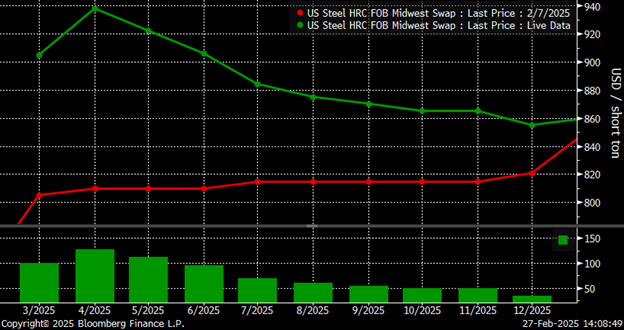Futures

CRU Aluminum: Secondary Aluminum to Play A Bigger Role Over The Next 2-3 Years
Written by Matthew Abrams
October 6, 2023
The LME aluminum three-month price was broadly unchanged on Friday morning, Oct. 6, and was last seen trading at $2,243 per ton.
Due to the Mid-Autumn Festival and National Day celebrations, the SHFE is closed for holidays from Sept. 29 to Oct. 6.

According to a report from Bloomberg, leaders from the EU and the US are working towards announcing an interim agreement during a summit on Oct. 20 regarding steel and aluminum trade.
This agreement aims to prevent the reinstatement of tariffs from the Trump era on transatlantic commerce. This agreement would encompass the key components of the Global Arrangement for Sustainable Steel and Aluminium, a negotiation process that the EU and the US have been involved in since 2021.
These components include addressing issues related to non-market excess capacity and carbon emissions, as sources familiar with the discussions cited in the report.
IRA And Infrastructure Bill Spending Ramping Up Further Ahead of Election Year
Government spending on nonresidential construction projects is still likely to provide a boost to demand over the next 6-12 months. This funding will flow through the Infrastructure Bill and the Inflation Reduction Act (IRA). Given that next year is an election year, the Biden administration will want to push the economic growth as high as possible and this legislation could be a vice for that.
Recently, new funding for clean energy buses (both public and school), new railway cars, and other important infrastructure projects have started to distribute funds.
A spillover effect from these projects is the higher priority given to low-carbon aluminum with higher recycled content. The Government Service Administration (GSA) recently announced a pilot program for low-embodied carbon materials used in new construction under the IRA.
Currently, asphalt, concrete, steel, and glass are included. Initially, aluminum was marked for phase two of this rollout. This would require domestic producers to produce EPDs and to get certified to have the chance to contribute to over $2 billion worth of projects.
With demand for higher recycled content aluminum already projected to grow, the recycling supply chain has even more of a reason to adapt.
With two new rolling mills slated to come online in the next 2-3 years the supply of recycled aluminum was already drawn into question. Scrap spreads will likely tighten and there could be further local government focus on methods to raise recycle rates of key materials such as used beverage cans. A significant amount of scrap is still being exported so we will see domestic producers compete to keep that vital supply onshore.
SAFE Foundation Pens Letter in Support of Domestic Investments in Primary Smelting
Also, IRA-related, last week the SAFE foundation alongside Ford Motor Co., General Motors, Pepsi Co., Rivian, SunPower, and eight other companies wrote a letter to the US Department of Energy Secretary Jennifer Granholm. The letter is the latest call from the foundation for more support for the domestic supply chain of aluminum.
To make their point, they refer to the six remaining aluminum smelters still operating in the US.
“Spiking electricity prices, lack of access to low-cost renewable energy, and insufficient federal investment have pushed the remaining six primary smelters to the brink,” the letter states. “The IRA is poised to make the largest-ever investment in US manufacturing, supercharging aluminum-dependent clean energy technologies. In order to meet increased aluminum demand that will affect all our industries, the U.S. must invest heavily in supply.”
The aluminum industry’s reliance on fossil fuels has put its future in jeopardy, the letter said.
Power supply accounts for 40% of US smelters’ total production costs. Smelters in Kentucky and Indiana said high energy costs due to volatile fossil fuel prices necessitated curtailing operations last year. At the same time, the price of electricity from renewable sources like wind and solar has plummeted over the last 10 years.
Rather than allow these smelters to become priced out, the federal government can secure low-cost electricity supplies in the short term while investing in long-term supplies of cheap, renewable energy.
The IRA and Infrastructure bills are both opportunities to support these initiatives due to both aluminum’s continued importance to US production of goods and its carbon intensity.
With primary aluminum being relatively high on the carbon intensity scale coupled with secondary aluminum being infinitely recyclable, more investments in the domestic supply chain fit with current ESG goals. With more and more domestic capacity added further downstream by both extruders and rollers, further investment in domestic primary and secondary capacity would reduce the supply chain’s reliance on imports.
Learn more about CRU’s services at www.crugroup.com
Matthew Abrams
Read more from Matthew AbramsLatest in Futures

HR Futures: Nascent rally in HRC futures settles above 6-week downtrend
The CME Midwest HRC futures market’s response to Trump’s election and subsequent comments about blanket 25% tariffs on Canada and Mexico was surprisingly counterintuitive.

HR Futures: Market at crossroads after turbulent run
The market appears to be pausing after a turbulent run. But tension remains just beneath the surface. With net long positioning still elevated, sentiment-driven selling could quickly reignite volatility. Still, supply constraints and limited imports are laying the groundwork for a resilient physical market. This moment of calm feels more like a crossroads than a conclusion.

HR Futures: Traders’ views mixed as market navigates tariffs
A look at the HR futures market.

Market pressures trigger HR futures reversal
Market dynamics are shifting rapidly, with futures pricing diverging from physical fundamentals, creating a complex landscape for steel traders.

HR Futures: Correction in market after big rally
Another eventful week in the physical and financial steel markets is coming to a close, but with a markedly different tone than the last update at the end of February.
